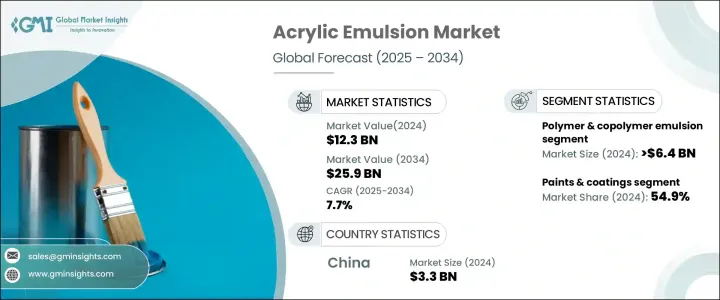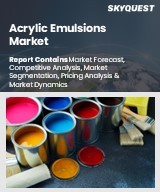
|
시장보고서
상품코드
1684758
세계의 아크릴 에멀젼 시장 : 기회, 성장 촉진요인, 산업 동향 분석, 예측(2025-2034년)Acrylic Emulsion Market Opportunity, Growth Drivers, Industry Trend Analysis, and Forecast 2025 - 2034 |
||||||
세계의 아크릴 에멀젼 시장은 2024년 123억 달러로 평가되었고, 2025년부터 2034년까지 CAGR 7.7%로 안정된 성장이 전망되고 있습니다.
FKM으로도 알려진 아크릴 에멀젼은 열, 화학 물질 및 다양한 유체에 대한 우수한 내성으로 특이한 합성 엘라스토머입니다. 이러한 특성으로 인해 아크릴 에멀젼은 자동차, 항공우주, 석유 및 가스, 화학 처리 등 내구성 있는 밀봉 솔루션이 필요한 산업에서 필수적입니다. 산업계가 기술 혁신을 계속하고 뛰어난 성능을 가진 재료를 요구하는 가운데 아크릴 에멀젼 시장은 크게 확대되는 좋은 위치에 있습니다. 친환경적이고 고성능 재료에 대한 요구 증가는 특히 건설, 자동차 및 산업 분야에서 아크릴 에멀젼에 대한 수요를 더욱 강화하고 있습니다.

폴리머 및 코폴리머 에멀젼 부문은 2024년에 64억 달러를 생산했습니다. 이 분야는 다양한 산업 응용 분야에 적합한 특정 특성을 강화하는 추가적인 중합체와 공중합체에서 특히 주목받고 있습니다. 이 에멀젼은 접착제, 실란트 및 특수 코팅제에 널리 사용되며 다양한 시장 수요에 대응하는 다용도와 효율성을 모두 제공합니다. 산업계가 점점 첨단 제조 기술을 채택함에 따라 이러한 에멀젼 수요는 꾸준히 증가하고 시장에서 지속적인 이점을 확보할 것으로 예상됩니다.
| 시장 범위 | |
|---|---|
| 시작 연도 | 2024년 |
| 예측 연도 | 2025-2034년 |
| 시작 금액 | 123억 달러 |
| 예측 금액 | 259억 달러 |
| CAGR | 7.7% |
2024년에는 페인트 및 코팅 분야가 54.9%의 큰 점유율로 시장을 독점했으며, 2034년까지 크게 성장할 것으로 예측됩니다. 아크릴 에멀젼은 뛰어난 접착성, 내후성, 내구성으로 고급 페인트 및 코팅제에 특히 선호됩니다. 이러한 기본 특성은 오래 지속되고 미관이 뛰어난 마무리 생산에 기여하며 자동차, 아키텍처 및 소비재를 포함한 다양한 산업에서 수요를 이끌고 있습니다. 환경 과제를 견디는 고품질의 마감재가 요구되고 있기 때문에 이 분야는 앞으로도 대폭적인 성장을 계속할 것으로 예상됩니다.
중국의 아크릴 에멀젼 시장은 2024년에 33억 달러에 달했고, 2025년부터 2034년까지 눈부신 성장을 이룰 것으로 예상됩니다. 아크릴 에멀젼은 페인트, 코팅제, 건축자재 첨가제에 널리 사용되고 있기 때문에 중국과 인도의 건설 산업의 급속한 확대가이 수요를 크게 견인하고 있습니다. 도시화는 대규모 인프라 프로젝트의 성장과 함께 시장 규모 확대에 중요한 역할을 하고 있습니다. 게다가 일본이나 한국과 같은 국가에서는 자동차 산업이 활발해 아크릴 에멀젼의 안정된 수요에 공헌하고 있습니다. 이 지역은 산업 성장의 최전선에 계속되기 때문에 아크릴 에멀젼 수요는 계속 증가하고 세계 시장의 확대에 기여할 것으로 예상됩니다.
목차
제1장 조사 방법과 조사 범위
- 시장 범위와 정의
- 기본 추정과 계산
- 예측 계산
- 데이터 소스
- 1차 데이터
- 2차 데이터
- 유료 정보원
- 공적 정보원
제2장 주요 요약
제3장 업계 인사이트
- 생태계 분석
- 밸류체인에 영향을 주는 요인
- 이익률 분석
- 파괴
- 미래의 전망
- 제조업체
- 유통업체
- 공급자의 상황
- 이익률 분석
- 주요 뉴스
- 규제 상황
- 영향요인
- 성장 촉진요인
- 친환경 저VOC 페인트에 대한 수요 증가
- 아크릴 에멀젼계 도료 수요를 견인하는 건설 업계의 성장
- 기능 마무리에 아크릴 에멀젼을 활용하는 섬유 산업의 성장
- 업계의 잠재적 위험 및 과제
- 친환경 저VOC 페인트에 대한 수요 증가
- 아크릴 에멀젼계 도료 수요를 견인하는 건설 업계의 성장
- 기능 마무리에 아크릴 에멀젼을 활용하는 섬유 산업의 성장
- 성장 촉진요인
- 성장 가능성 분석
- Porter's Five Forces 분석
- PESTEL 분석
제4장 경쟁 구도
- 소개
- 기업 점유율 분석
- 경쟁 포지셔닝 매트릭스
- 전략 전망 매트릭스
제5장 시장 규모와 예측 : 유형별, 2021-2034년
- 주요 동향
- 순 아크릴 에멀젼
- 폴리머 및 코폴리머 아크릴 에멀젼
제6장 시장 규모와 예측 : 용도별, 2021-2034년
- 주요 동향
- 페인트
- 접착제 및 실란트
- 건축자재 첨가제
- 종이용 코팅제
- 기타
제7장 시장 규모와 예측 : 최종용도산업별, 2021-2034년
- 주요 동향
- 건설
- 자동차
- 섬유
- 기타
제8장 시장 규모와 예측 : 지역별, 2021-2034년
- 주요 동향
- 북미
- 미국
- 캐나다
- 유럽
- 영국
- 독일
- 프랑스
- 이탈리아
- 스페인
- 러시아
- 아시아태평양
- 중국
- 인도
- 일본
- 한국
- 호주
- 라틴아메리카
- 브라질
- 멕시코
- 중동 및 아프리카
- 남아프리카
- 사우디아라비아
- 아랍에미리트(UAE)
제9장 기업 프로파일
- Alv Kimya
- Arkema Group
- Avery Dennison Performance Polymers
- BASF
- Celanese
- Covestro
- DIC
- Dow Inc
- Henkel Additives
- HB Fuller
- Jensen & Nicholson
- Mallard Creek Polymers
- Max Paints
- Mitsui Chemicals
The Global Acrylic Emulsion Market was valued at USD 12.3 billion in 2024 and is expected to experience steady growth at a CAGR of 7.7% between 2025 and 2034. Acrylic emulsions, also known as FKM, are synthetic elastomers prized for their remarkable resistance to heat, chemicals, and a range of fluids. These characteristics make acrylic emulsions indispensable in industries that require durable sealing solutions, such as automotive, aerospace, oil and gas, and chemical processing. As industries continue to innovate and demand materials with superior performance, the acrylic emulsion market is well-positioned for significant expansion. The growing need for eco-friendly and high-performance materials further strengthens the demand for acrylic emulsions, especially in the construction, automotive, and industrial sectors.

The polymer and copolymer emulsion segment generated USD 6.4 billion in 2024. This segment is particularly notable for its additional polymers and copolymers, which enhance specific properties suited for various industrial applications. These emulsions are widely used in adhesives, sealants, and specialized coatings, offering both versatility and efficiency in meeting diverse market demands. As industries adopt increasingly advanced manufacturing techniques, the demand for these emulsions is expected to rise steadily, ensuring their continued prominence in the marketplace.
| Market Scope | |
|---|---|
| Start Year | 2024 |
| Forecast Year | 2025-2034 |
| Start Value | $12.3 Billion |
| Forecast Value | $25.9 Billion |
| CAGR | 7.7% |
In 2024, the paints and coatings segment dominated the market with a significant 54.9% share and is forecast to grow substantially by 2034. Acrylic emulsions are especially favored for premium paints and coatings due to their superior adhesion, weathering resistance, and durability. These essential properties contribute to the production of long-lasting, aesthetically pleasing finishes, driving demand across various industries, including automotive, architecture, and consumer goods. The need for high-quality finishes that stand up to environmental challenges ensures that this segment will continue to see substantial growth in the coming years.
China acrylic emulsion market reached USD 3.3 billion in 2024 and is projected to grow at an impressive rate between 2025 and 2034. The rapid expansion of the construction industry in China and India significantly drives this demand, as acrylic emulsions are extensively used in paints, coatings, and construction material additives. Urbanization, along with the growth of large-scale infrastructure projects, is playing a key role in increasing the market's size. Furthermore, the thriving automotive sector in countries like Japan and South Korea continues to contribute to the consistent demand for acrylic emulsions. As these regions remain at the forefront of industrial growth, the demand for acrylic emulsions is expected to keep rising, contributing to the global market's expansion.
Table of Contents
Chapter 1 Methodology & Scope
- 1.1 Market scope & definition
- 1.2 Base estimates & calculations
- 1.3 Forecast calculation
- 1.4 Data sources
- 1.4.1 Primary
- 1.4.2 Secondary
- 1.4.2.1 Paid sources
- 1.4.2.2 Public sources
Chapter 2 Executive Summary
- 2.1 Industry synopsis, 2021-2034
Chapter 3 Industry Insights
- 3.1 Industry ecosystem analysis
- 3.1.1 Factor affecting the value chain
- 3.1.2 Profit margin analysis
- 3.1.3 Disruptions
- 3.1.4 Future outlook
- 3.1.5 Manufacturers
- 3.1.6 Distributors
- 3.2 Supplier landscape
- 3.3 Profit margin analysis
- 3.4 Key news & initiatives
- 3.5 Regulatory landscape
- 3.6 Impact forces
- 3.6.1 Growth drivers
- 3.6.1.1 Increasing demand for eco-friendly and low-VOC coatings
- 3.6.1.2 Growth in the construction industry, driving demand for acrylic emulsion-based paints
- 3.6.1.3 Growth in the textile industry, leveraging acrylic emulsions in functional finishes
- 3.6.2 Industry pitfalls & challenges
- 3.6.2.1 Increasing demand for eco-friendly and low-VOC coatings
- 3.6.2.2 Growth in the construction industry, driving demand for acrylic emulsion-based paints
- 3.6.2.3 Growth in the textile industry, leveraging acrylic emulsions in functional finishes
- 3.6.1 Growth drivers
- 3.7 Growth potential analysis
- 3.8 Porter’s analysis
- 3.9 PESTEL analysis
Chapter 4 Competitive Landscape, 2024
- 4.1 Introduction
- 4.2 Company market share analysis
- 4.3 Competitive positioning matrix
- 4.4 Strategic outlook matrix
Chapter 5 Market Size and Forecast, By Type, 2021-2034 (USD Billion) (Kilo Tons)
- 5.1 Key trends
- 5.2 Pure acrylic emulsion
- 5.3 Polymer & copolymer acrylic emulsion
Chapter 6 Market Size and Forecast, By Application, 2021-2034 (USD Billion) (Kilo Tons)
- 6.1 Key trends
- 6.2 Paints & coatings
- 6.3 Adhesives & sealants
- 6.4 Construction material additives
- 6.5 Paper coatings
- 6.6 Other
Chapter 7 Market Size and Forecast, By End Use Industries, 2021-2034 (USD Billion) (Kilo Tons)
- 7.1 Key trends
- 7.2 Construction
- 7.3 Automobile
- 7.4 Textile
- 7.5 Other
Chapter 8 Market Size and Forecast, By Region, 2021-2034 (USD Billion) (Kilo Tons)
- 8.1 Key trends
- 8.2 North America
- 8.2.1 U.S.
- 8.2.2 Canada
- 8.3 Europe
- 8.3.1 UK
- 8.3.2 Germany
- 8.3.3 France
- 8.3.4 Italy
- 8.3.5 Spain
- 8.3.6 Russia
- 8.4 Asia Pacific
- 8.4.1 China
- 8.4.2 India
- 8.4.3 Japan
- 8.4.4 South Korea
- 8.4.5 Australia
- 8.5 Latin America
- 8.5.1 Brazil
- 8.5.2 Mexico
- 8.6 MEA
- 8.6.1 South Africa
- 8.6.2 Saudi Arabia
- 8.6.3 UAE
Chapter 9 Company Profiles
- 9.1 Alv Kimya
- 9.2 Arkema Group
- 9.3 Avery Dennison Performance Polymers
- 9.4 BASF
- 9.5 Celanese
- 9.6 Covestro
- 9.7 DIC
- 9.8 Dow Inc
- 9.9 Henkel Additives
- 9.10 H.B. Fuller
- 9.11 Jensen & Nicholson
- 9.12 Mallard Creek Polymers
- 9.13 Max Paints
- 9.14 Mitsui Chemicals















